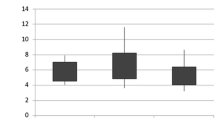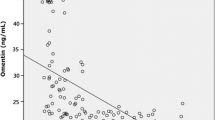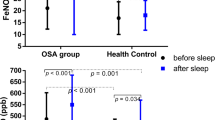Abstract
The objectives of the present study were to assess the level of exhaled breath markers indicating airway inflammation and oxidative stress in patients with obstructive sleep apnoea syndrome (OSAS) in comparison with non-apnoeic (obese and non-obese) subjects and investigate whether therapy with continuous positive airway pressure (CPAP) can modify them. The design was a retrospective observational study, set in Evgeneidio Hospital. Twenty-six OSAS patients and nine obese and 10 non-obese non-apnoeic subjects participated in this study. We measured nasal nitric oxide (nNO), exhaled nitric oxide (eNO), exhaled carbon monoxide (eCO) in exhaled breath, and 8-isoprostane, leukotriene B4 (LTB4), nitrates, hydrogen peroxide (H2O2), and pH in exhaled breath condensate (EBC) before and after 1 month of CPAP therapy. The levels of eNO and eCO were higher in OSAS patients than in control subjects (p < 0.05). Nasal NO was higher in OSAS patients than in obese controls (p < 0.01). The level of H2O2, 8-isoprostane, LTB4, and nitrates were elevated in OSAS patients in comparison with obese subjects (p < 0.01). Conversely, pH was lower in OSAS patients than in non-apnoeic controls (p < 0.01). One month of CPAP therapy increased pH (p < 0.05) and reduced eNO (p < 0.001) and nNO (p < 0.05). Apnea/hypopnoea index was positively correlated with 8-isoprostane (r = 0.42; p < 0.05), LTB4 (r = 0.35; p < 0.05), nitrates (r = 0.54; p < 0.001), and H2O2 (r = 0.42; p < 0.05). Airway inflammation and oxidative stress are present in the airway of OSAS patients in contrast to non-apnoeic subjects. Exhaled breath markers are positively correlated with the severity of OSAS. One-month administration of CPAP improved airway inflammation and oxidative stress.



Similar content being viewed by others
References
Young T, Palta M, Dempsey J, Skatrud J, Weber S, Badr S (1993) The occurrence of sleep-disordered breathing among middle-aged adults. N Engl J Med 328:1230–1235
Peker Y, Hedner J, Norum J, Kraiczi H, Carlson J (2002) Increased incidence of cardiovascular disease in middle-aged men with obstructive sleep apnea. A 7-year follow-up. Am J Respir Crit Care Med 166:159–165
Peppard PE, Young T, Palta M, Skatrud J (2000) Prospective study of the association between sleep disordered breathing and hypertension. N Engl J Med 342:1378–1384
Mathur S, Devaraj S, Jialal I (2002) Accelerated atherosclerosis, dyslipidemia, and oxidative stress in end-stage renal disease. Curr Opin Nephrol Hypertens 11:141–147
Lavie L (2003) Obstructive sleep apnoea—an oxidative stress disorder. Sleep Med Rev 7:35–51
Svatikova A, Wolk R, Lerman L, Juncos L, Greene E, Mc Connell J, Somers V (2005) Oxidative stress in obstructive sleep apnoea. Eur Heart J 26:2435–2439
Carpagnano G, Kharitonov S, Resta O, Foschino-Barbaro M, Gramiccioni E, Barnes P (2002) Increased 8-isoprostane and Interleukin-6 in breath condensate of obstructive sleep apnoea patients. Chest 122:1162–1167
Schulz R, Mahmoudi S, Hattar K, Sibelius U, Olschewski H, Mayer K, Seeger W, Grimminger F (2000) Enhanced release of superoxide from polymorphonuclear neutrophils in obstructive sleep apnea. Impact of continuous positive airway pressure therapy. Am J Respir Crit Care Med 162:566–570
Wali S, Bahammam A, Massaeli H, Pierce G, Iliskovic N, Singal P, Kryger M (1998) Susceptibility of LDL to oxidative stress in obstructive sleep apnea. Sleep 21:290–296
Muns G, Rubistein I, Bergmann K (1995) Phagocytosis and oxidative burst of blood phagocytes in chronic obstructive airway disease. Scand J Infect Dis 27:369–373
Dyugovskaya L, Lavie P, Lavie L (2002) Increased adhesion molecules expression and production of reactive oxygen species in leykocytes of sleep apnea patients. Am J Respir Crit Care Med 165:934–939
Olopade C, Christon J, Zakkar M, Hua C, Swedler W, Scheff P, Rubinstein I (1997) Exhaled pentane and nitric oxide levels in patients with obstructive sleep apnea. Chest 111:1500–1504
Agusti AG, Barbe F, Togores B (1999) Exhaled nitric oxide in patients with sleep apnea. Sleep 22:231–235
Kharitonov S, Barnes P (2001) Exhaled markers of inflammation. Curr Opin Allergy Clin Immunol 1:217–224
Rechtschaffen A, Kales A (eds) (1968) A manual of standardized terminology, techniques and scoring system for sleep stages of human subjects. National Institutes of Health, Bethesda
American Academy of Sleep Medicine Task Force (1999) Sleep-related breathing disorders in adults: recommendations for syndrome definition and measurement techniques in clinical research. Sleep 22:667–689
ATS/ERS Task Force on Exhaled Breath Condensate (2005) Exhaled breath condensate: methodological recommendations and unresolved questions. Eur Respir J 26:523–548
Hunt JF, Fang K, Malik R, Snyder A, Malhotra N, Platts-Mills TAE, Gaston B (2000) Endogenous airway acidification: implications for asthma pathology. Am J Respir Crit Care Med 161:694–699
Gallati H, Pracht I (1985) Horseradish peroxidase: kinetic studies and optimization of peroxidase activity determination using the substrates H2O2 and 3,3,5,5-tetramethylbenzidine. J Clin Chem Clin Biochem 23:453–460
Kharitonov S, Barnes P (2001) Exhaled markers of pulmonary disease. Am J Respir Crit Care Med 163:1693–1722
Janssen-Heininger Y, Persinger R, Korn S, Pantano C, McElhinney B, Reynaert N, Langen R, Ckless K, Shrivastava P, Poynter M (2002) Reactive nitrogen species and cell signaling: implications for death or survival of lung epithelium. Am J Respir Crit Care Med 166:S9–S16
Struben V, Wieringa M, Feenstra L, De Jongste J (2006) Nasal nitric oxide and nasal allergy. Allergy 61:665–670
Kharitonov S, Barnes P (2006) Exhaled biomarkers. Chest 130:1541–1546
Predi P, Kharitonov S, Barnes P (2002) Analysis of expired air for oxidation products. Am J Respir Crit Care Med 166:S31–S37
Montuschi P, Ciabattoni G, Paredi P, Pantelidis P, du Bois RM, Kharitonov S, Barnes P (1998) 8-Isoprostane as a biomarker of oxidative stress in interstitial lung diseases. Am J Respir Crit Care Med 158:1524–1527
Carpagnano GE, Kharitonov SA, Resta O, Foschino-Barbaro M, Gramiccioni E, Barnes P (2003) 8-Isoprostane, a marker of oxidative stress, is increased in exhaled breath condensate of patients with obstructive sleep apnea after night and is reduced by continuous positive airway pressure therapy. Chest 124:1386–1392
Vgontzas A, Papanicolaou D, Bixler E Kales A, Tyson K, Chrousos G (1997) Elevation of plasma cytokines in disorders of excessive daytime sleepiness: role of sleep disturbance and obesity. Clin Endocrinol Metab 82:1313–1316
Nicosia S, Capra V, Rovati G (2001) Leukotriens as mediators of asthma. Pulm Pharmacol Ther 14:3–19
Montuschi P, Barnes P (2002) Analysis of exhaled breath condensate for monitoring airway inflammation. Trends Pharmacol Sci 23:232–237
Kostikas K, Papatheodorou G, Ganas K, Psathakis K, Panagou P, Loukides S (2002) pH in expired breath condensate of patients with inflammatory airway diseases. Am J Respir Crit Care Med 165:1364–1370
Leung T, Li C, Lam C, Au C, Yung E, Chan I, Wong G, Fok T (2004) The relationship between obesity and asthmatic airway inflammation. Pediatr Allergy Immunol 15:344–350
Author information
Authors and Affiliations
Corresponding author
Rights and permissions
About this article
Cite this article
Petrosyan, M., Perraki, E., Simoes, D. et al. Exhaled breath markers in patients with obstructive sleep apnoea. Sleep Breath 12, 207–215 (2008). https://doi.org/10.1007/s11325-007-0160-8
Received:
Revised:
Accepted:
Published:
Issue Date:
DOI: https://doi.org/10.1007/s11325-007-0160-8




